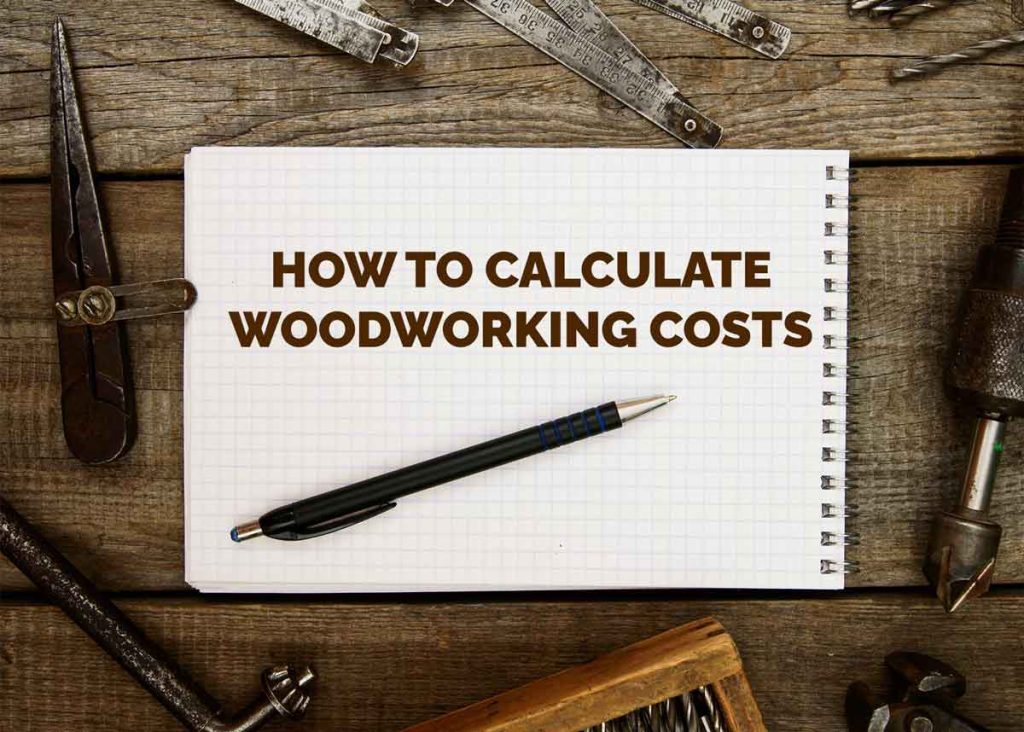Wondering how much to charge for woodworking? This simple formula will help you know exactly how to price your woodworking projects to sell!
When you make handmade items, it can be tricky to know how much to charge or what price you should give your products. You have to factor in things like your materials costs, your labor costs, the costs of tools, expenses with running your shop, and of course marketing expenses as well.
Fortunately, I have a simple formula you can use to calculate how much to charge for your woodworking products and see a profit from your work.

The Simple Formula for Calculating Woodworking Prices
Here is my formula for calculating prices for your woodworking shop.
Cost of Materials + Cost of Labor + Operating Costs + Other Business Expenses + Profit Margin = Price of Product
Many small business woodworkers often underestimate their true costs for making their projects sell at a profit. While the formula is very simple, I want to help make sure you are really charging enough for what you make to sell! Let’s take a look at how to calculate your expenses.
How to Calculate Your WoodWorking Expenses
When you are calculating your costs, you want to consider these 4 things:
Cost of Materials: This one is self-explanatory – what’s it cost in materials? Don’t forget things like glue, hardware, and paint or stain!
Cost of Labor: When you calculate your costs to make something, it is VERY important that you consider your labor costs. Too many people make the mistake of assuming costs only means the cost of materials. Not so!
Operating Costs: This is what it costs you to run your woodworking shop. This may include electricity, tools, the gas you use to drive to a store to get materials.
Other Business Expenses: On top of your other costs, you have to figure out expenses like shipping, insurance, fees for selling online, hosting your own website, marketing, and advertising costs.
Once you have calculated all those things, then you can calculate the profit margin you want to make and know exactly how to price your products. Let’s break down each of these 4 main expenses to make sure you aren’t missing anything when you factor in how much to charge for woodworking.
How to Calculate Costs of Materials and Supplies

When you are running a business, it’s very important that your supply costs are as low as possible. While lumber is a commodity and the prices are generally the same no matter where you go, you do have to think about how you can maximize your profits from the wood you buy.
The first thing to make sure you’re doing is to ensure you use every square inch of wood that is possible! There are lots of great scrap wood projects you could make to sell in addition to your primary products!
Buying things like glue, paint, sandpaper, or stain in bulk can save you a lot of money down the road, but you also have to consider you might be able to make several products out of these things.
Let’s say a bottle of glue costs $6 and you only use about 1/8 of the bottle for your project. You would calculate 1/8 of $6 so .125 x $6 = 75 cents.
Obviously, the cheaper you can get your supplies the better, but this should help you get a good idea of what it costs for items where you might get several products from it.
The same thing goes with nails – it’s cheaper to buy nails in bulk. Take the cost of the nails (Let’s say $59) and divide it by the number of nails in the package (Let’s say 1920 nails) – Your cost per nail is around 4 cents a nail. If your project needs 18 nails, multiply 18 x 4 and your total cost for nails is about 18 cents.
You might not be worried about 18 cents or even 75 cents, but when you are making multiple products a month those little costs really add up! If you make 25 woodworking projects a month – that’s $25 you might have not considered!
Now that we’ve talked about costs of materials and supplies, let’s get into calculating your labor costs.
How to Calculate Your Labor Costs
In order to calculate your labor costs, first determine how much you want to earn an hour. Everyone’s hourly rate will be different and it really depends on what you need to make and what you believe is fair.
For example’s sake, let’s say you want to make $20/hour. If a woodworking project takes you 5 hours to make, you would simply multiply $20 by 5 to get $100. That’s your labor cost.
When determining how much you want to make per hour, consider what a fair rate would be as well as whether that rate is going to be realistic for people to pay. It depends on what you are making – a cabinet maker can charge a heck of a lot more per hour than someone making wooden signs, simply because it requires a lot more effort, detail, and skill.
At the very least, you should pay yourself whatever minimum wage is in your state. Where we live, our state has the same minimum wage as the federal rate. Other states have higher minimum wages, usually because the cost of living is higher.
Another aspect of labor you want to consider in your costs is the time you spend marketing and selling your products – and of course also cleaning up your woodshop!
Think about it if you were an employee – you wouldn’t be paid for your time just while you were building – you’d also get paid hourly for time spent listing products online, sitting in a vendor booth, and even when it’s time to clean up the saw dust in your shop and put the tools away. (Hopefully, you have a nice saw dust collection system that makes it go quickly!)
These costs can be hard to factor into a price, but consider about how much time you spend doing these things and how many products you make per month.
For example, let’s say you spend about 10 hours a week doing other activities besides building items. Multiply that by your hourly rate (Let’s say $20 again) and that’s $200/week, or $800 a month. Trust me when I say most small business owners don’t think about this, but that’s a LOT of time + money to just ignore!
Now, think about how many products you make a month. Maybe you only make one product – an elaborate custom cabinet. Make sure you factor in those costs in that price!
If you make 40 products a month, you would divide $800 by 40 for $20 per product, so you could add that $20 to the price of the product.
Now, the skills for sitting in a vendor booth or listing things online aren’t quite the same as the skill of being able to make something beautiful out of wood – so you may want to pay yourself a lower salary in those cases. Again, make sure it is at least minimum wage!
All right, now that we’ve calculated our labor costs, let’s figure out your operating costs!
Calculating Operating Costs + Other Expenses
It’s important you calculate your costs for tools and the expenses of running your shop. After all, almost all power tools require electricity and you certainly will want the lights on while you are working! If one of your tools needs to be replaced, that’s another expense you have to consider.
You will likely also have other expenses, such as paying for gas for your vehicle to go to the store to buy materials, insurance for your business, fees for setting up a booth at a craft fair or online fees for selling on sites like Etsy or the cost of hosting for your own website.
These costs are going to be different for everyone, but here’s a list of things you might want to factor in:
- Insurance Costs
- Gas + Vehicle Costs
- Online Selling Fees (Etsy, PayPal fees, etc.)
- Shipping and Delivery Costs
- Website Hosting + Domain Renewal
- Cell Phone Costs
- Internet Costs
- Electricity Costs
- Advertising and Marketing Costs
- Vendor Booth Supplies (tables, tablecloths, signs, shelves, etc.)
- Cost of Tool Maintenance + Replacements
You may not have all of the costs listed above or you may have others not listed. Some things like utilities may be tricky to calculate your true expenses for your business if you are working from home. If you use your cell phone + internet mostly for personal use, you may not even want to include that at all.
To factor in these costs in your pricing, we’re going to again want to add them all up for the month and then divide them by the number of products you make per month. So let’s say your total costs here are about $300 and you make 40 products per month – that’s 300 divided by $40 for $7.5.
Now that we’ve calculated all our costs, we need to add them together. Here’s a breakdown of what it might look like for you:
Supply + Material Cost: $12
Labor Cost Per Product: $120
Operating Costs + Other Business Expenses: $7.50
Total Cost: $139.50
As you can see in our example, the total cost for making something would be about $139.50. Obviously, this amount is going to be different for everyone – it’s also going to be different for each different product you make. A coffee table might cost you $139 to make, but a jewelry box might only cost about $50 to make.
But wait! We are not done! To truly run a business, you MUST mark up your products to make a profit. Selling things at cost is not going to help you earn a full-time living with woodworking!

How to Calculate Profit Margin for Your Woodworking Projects
Like hourly rates, the profit margin is going to look different for everybody. It also greatly depends on the product you are making and selling. While you truly can market and sell anything for the price you want – you do have to consider your target market and what is a reasonable amount they will pay.
Let’s say that you are selling a coffee table. Most people will gladly pay at least $150 for a coffee table – all the way up to $300 or even $500.
If it cost you $112 to make the coffee table, and you charge $150 – you will see $38 in profit. That might not sound like a lot – but remember, with this formula you already factored in your labor costs. If you sell the coffee table for $500, you’re going to see a profit of $388.
You can also choose a profit margin by percentage. For example, let’s say you want to markup your products by 40%. 40% of $112 is $44.80, so you’d want to price it around $156.
Now, some items would be very difficult to sell for $156 – you’d have a very hard time selling a small wooden bowl or small jewelry box for that price. But, if you can get a system down so you are maximizing your time spent, you can probably get your labor costs way down. You will also be able to make more of those smaller products, so your other costs will be lower as well.
Remember, you can always change your hourly rate and profit margin to match the current market prices for the products you sell.
I hope this guide to pricing your woodworking products to sell is helpful for you. Remember: You must make a living wage and you are worth it to charge higher prices. You are an artist and people are usually willing to support small business owners and understand their costs aren’t the same as something mass-produced in a factory – but that’s also why they want to buy from you!
Do you have any questions about pricing your woodworking products to sell? Have any tips to help woodworkers know what to charge? I’d love to hear from you in the comments section below!

This is great,i have learn something from you
Thank you very much